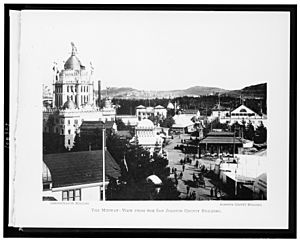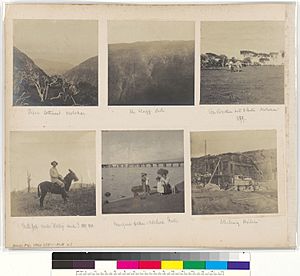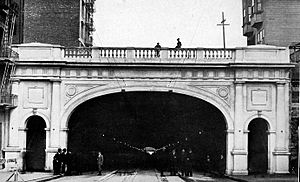Michael O'Shaughnessy facts for kids
Quick facts for kids
Michael O' Shaughnessy
|
|
|---|---|
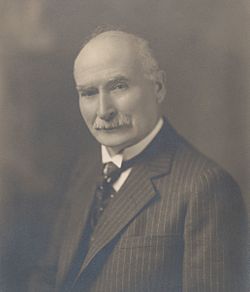
Michael O' Shaughnessy
|
|
| Born | 28 May 1864 |
| Died | 12 October 1934 (aged 70) |
| Nationality | Irish |
| Alma mater | NUI Galway |
| Occupation | Engineer |
| Spouse(s) | Mary Spottiswood |
| Children | 5 |
| Parent(s) | Patrick O'Shaughnessy Margaret O'Donnell |
Michael Maurice O'Shaughnessy (May 28, 1864 – October 12, 1934) was an amazing Irish civil engineer. He became the main engineer for San Francisco in the early 1900s. He helped build the city's public transport system, called Muni, and created the Hetch Hetchy water system.
Contents
Early Life and Moving to America
Michael O'Shaughnessy was born on May 28, 1864, in County Limerick, Ireland. His parents were farmers, Patrick and Margaret. He was one of nine children in his family.
When he was two years old, Michael went to live with his grandparents. He later attended Mount Trenchard National School. After trying farming for a short time, he decided to become a civil engineer. He studied at Rockwell College and the University of Galway. He graduated from the Royal University of Dublin in 1884.
In 1885, Michael decided to move to California. He sailed from Liverpool, England, to New York. From there, he took a train across the country. He arrived in San Francisco on March 30, 1885.
He married Mary Spottiswood in San Francisco on October 21, 1890.
Starting His Engineering Career
When Michael first arrived in San Francisco, he didn't immediately find a job. But he stayed active in the local Irish community. A friend helped him get his first job as an assistant engineer in January 1886. This job was for the Sierra Valley & Mohawk Railway in Plumas County, California.
After a few months, he started working for the Southern Pacific Railroad. Here, he helped plan and lay out several towns. These included Niles, Tracy, and Mill Valley. After this, Michael started his own engineering business.
In 1890, Michael helped design a way to bring water to Mill Valley from a nearby brook. He completed the design and surveys for this water project.
Michael also started working with the city of San Francisco in the early 1890s. He was hired to survey extensions for Market Street and Potrero Avenue. In 1893, he became the chief engineer for the California Midwinter International Exposition of 1894. This big event was held in Golden Gate Park. He had to work with John McLaren, who was very protective of the park's trees.
Later, Michael worked for the Mountain Copper Company in Shasta County, California. He oversaw the building of the Iron Mountain Railway (California). This was a 12-mile-long narrow-gauge railway built in 1895. He also surveyed other rail routes and water projects.
Working in Hawaii
In 1899, Michael traveled to the Territory of Hawaii. He was hired to map out what would become the Wailuku Sugar Plantation. He explored water tunnels and plantations on different islands. He was warned about Hawaii's heavy rains, so he wore special rubber gear. This made people laugh, but he was prepared for the wet weather!
He returned to Hawaii in September 1899 to work on another water project. He was hired as a consulting engineer for C. Brewer & Co.. He moved his engineering office from San Francisco to Hawaii in January 1900.
Michael became known as an expert water engineer in Hawaii. He worked on several large aqueduct projects. These included the Olokele aqueduct on Kauai (1901–1903) and the Koʻolau, also known as Nahiku Ditch, on Maui (1903–1904). The Nahiku Ditch included a 7.5-mile-long tunnel section. He also worked on the Kohala aqueduct on Hawaii island (1905–1906). This one had 45 tunnels!
Famous writer Jack London visited Hawaii in 1907. He praised O'Shaughnessy for his "magnificent irrigation scheme." This system used waterfalls to greatly increase sugar production.
Michael's time in Hawaii was interrupted by the 1906 San Francisco earthquake and fire. He quickly booked passage back to San Francisco to help.
Back to California Projects
After returning to San Francisco, Michael met with James Rolph. Rolph later became the Mayor of San Francisco. Michael also worked on the Morena Dam project near San Diego. This dam was being built to supply water to the city. Michael was hired as a consulting engineer for the project in May 1907. Water began flowing from the dam in 1909, ahead of schedule. The dam was fully completed in 1912.
Becoming San Francisco's City Engineer
In August 1912, Mayor Rolph asked Michael O'Shaughnessy to become San Francisco's city engineer. Michael was hesitant at first. But Mayor Rolph explained the huge challenges. Michael would need to manage several major projects. These included building the Hetch Hetchy water system, improving the city's water supply, and completing the Geary Street Railway. He also had to improve the sewer and fire protection systems.
The idea of rebuilding a city after the earthquake and fire excited Michael. He accepted the job.
Michael started as city engineer on September 1, 1912. He quickly began working to save money and keep projects on schedule. Under his leadership, the San Francisco Municipal Railway (Muni) began operating. It was the first public railway in San Francisco. The first line started service on December 28, 1912.
1914 was a very busy year for Muni. It was preparing to serve the Panama–Pacific International Exposition. Michael oversaw the completion of the Stockton Street Tunnel. He also started construction on the Twin Peaks Tunnel. This tunnel was a big project that helped connect different parts of the city. It was completed on July 14, 1917. The Twin Peaks Tunnel helped businesses along Market Street, doubling and even quadrupling their sales.
In 1919, Muni introduced the "O'Shaughnessy" badge. This badge was the service's logo until 1968. Michael also oversaw the building of the Sunset Tunnel in the 1920s. This was the last rail tunnel built in San Francisco until the 1970s.
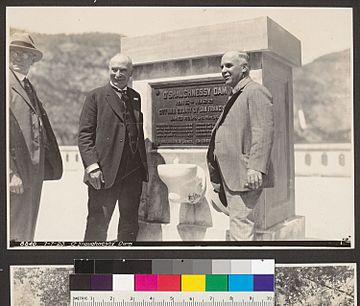
Besides public transportation, Michael also finished rebuilding the city's fire-fighting water and sewer systems. His plans for the Mile Rock Tunnel were approved in 1914. This large sewer tunnel drained much of the western part of the city. It was so big that officials, including Mayor Rolph and Michael, drove through it for an inspection!
Most of Michael's time as city engineer was spent on the Hetch Hetchy project. This huge project brought water from the Tuolumne River and Yosemite Valley to San Francisco. It was a distance of 167 miles! Work on the dam started in 1919. The dam was completed in 1923 and named O'Shaughnessy Dam in his honor.
Michael remained the city engineer until 1932. He then became a consulting engineer for the Hetch Hetchy Water Supply.
Michael O'Shaughnessy passed away from a heart attack on October 12, 1934. This was about two weeks before water from the O'Shaughnessy Dam finally reached the Bay Area. He was survived by his wife, Mary, and their five children. He was buried at Holy Cross Cemetery.
Legacy
The O'Shaughnessy Dam at Hetch Hetchy is named after him. This dam holds the water that supplies San Francisco.
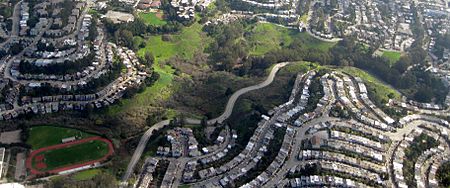
Also, O'Shaughnessy Boulevard in San Francisco is named in his honor. This street runs next to Glen Canyon Park. The area west of the boulevard is even called O'Shaughnessy Hollow. Muni still runs a busy bus route, the 44 O'Shaughnessy, along this street today.


